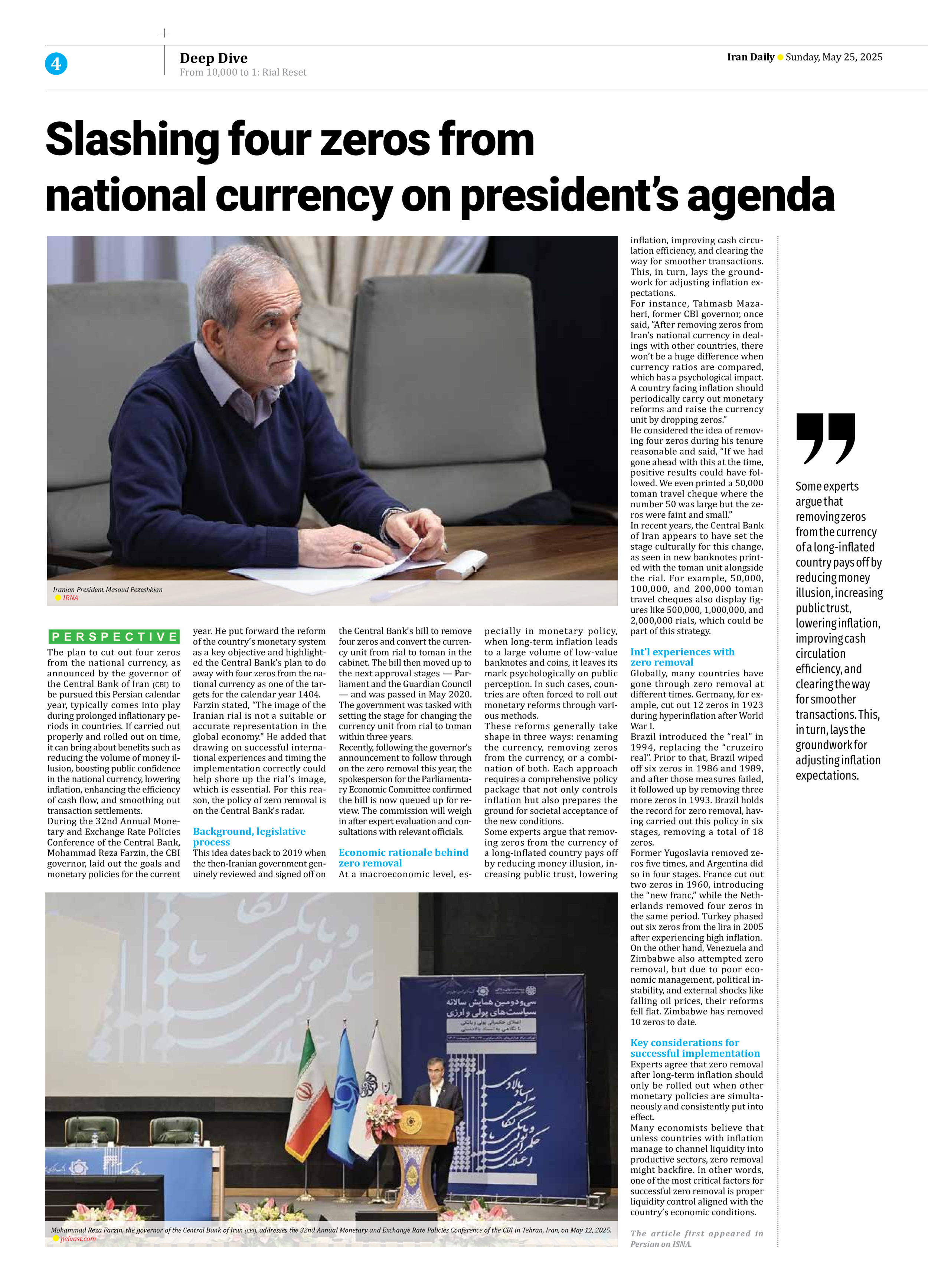
Slashing four zeros from national currency on president’s agenda
The plan to cut out four zeros from the national currency, as announced by the governor of the Central Bank of Iran (CBI) to be pursued this Persian calendar year, typically comes into play during prolonged inflationary periods in countries. If carried out properly and rolled out on time, it can bring about benefits such as reducing the volume of money illusion, boosting public confidence in the national currency, lowering inflation, enhancing the efficiency of cash flow, and smoothing out transaction settlements.
During the 32nd Annual Monetary and Exchange Rate Policies Conference of the Central Bank, Mohammad Reza Farzin, the CBI governor, laid out the goals and monetary policies for the current year. He put forward the reform of the country’s monetary system as a key objective and highlighted the Central Bank’s plan to do away with four zeros from the national currency as one of the targets for the calendar year 1404.
Farzin stated, “The image of the Iranian rial is not a suitable or accurate representation in the global economy.” He added that drawing on successful international experiences and timing the implementation correctly could help shore up the rial’s image, which is essential. For this reason, the policy of zero removal is on the Central Bank’s radar.
Background, legislative process
This idea dates back to 2019 when the then-Iranian government genuinely reviewed and signed off on the Central Bank’s bill to remove four zeros and convert the currency unit from rial to toman in the cabinet. The bill then moved up to the next approval stages — Parliament and the Guardian Council — and was passed in May 2020. The government was tasked with setting the stage for changing the currency unit from rial to toman within three years.
Recently, following the governor’s announcement to follow through on the zero removal this year, the spokesperson for the Parliamentary Economic Committee confirmed the bill is now queued up for review. The commission will weigh in after expert evaluation and consultations with relevant officials.
Economic rationale behind zero removal
At a macroeconomic level, especially in monetary policy, when long-term inflation leads to a large volume of low-value banknotes and coins, it leaves its mark psychologically on public perception. In such cases, countries are often forced to roll out monetary reforms through various methods.
These reforms generally take shape in three ways: renaming the currency, removing zeros from the currency, or a combination of both. Each approach requires a comprehensive policy package that not only controls inflation but also prepares the ground for societal acceptance of the new conditions.
Some experts argue that removing zeros from the currency of a long-inflated country pays off by reducing money illusion, increasing public trust, lowering inflation, improving cash circulation efficiency, and clearing the way for smoother transactions. This, in turn, lays the groundwork for adjusting inflation expectations.
For instance, Tahmasb Mazaheri, former CBI governor, once said, “After removing zeros from Iran’s national currency in dealings with other countries, there won’t be a huge difference when currency ratios are compared, which has a psychological impact. A country facing inflation should periodically carry out monetary reforms and raise the currency unit by dropping zeros.”
He considered the idea of removing four zeros during his tenure reasonable and said, “If we had gone ahead with this at the time, positive results could have followed. We even printed a 50,000 toman travel cheque where the number 50 was large but the zeros were faint and small.”
In recent years, the Central Bank of Iran appears to have set the stage culturally for this change, as seen in new banknotes printed with the toman unit alongside the rial. For example, 50,000, 100,000, and 200,000 toman travel cheques also display figures like 500,000, 1,000,000, and 2,000,000 rials, which could be part of this strategy.
Int’l experiences with
zero removal
Globally, many countries have gone through zero removal at different times. Germany, for example, cut out 12 zeros in 1923 during hyperinflation after World War I.
Brazil introduced the “real” in 1994, replacing the “cruzeiro real”. Prior to that, Brazil wiped off six zeros in 1986 and 1989, and after those measures failed, it followed up by removing three more zeros in 1993. Brazil holds the record for zero removal, having carried out this policy in six stages, removing a total of 18 zeros.
Former Yugoslavia removed zeros five times, and Argentina did so in four stages. France cut out two zeros in 1960, introducing the “new franc,” while the Netherlands removed four zeros in the same period. Turkey phased out six zeros from the lira in 2005 after experiencing high inflation.
On the other hand, Venezuela and Zimbabwe also attempted zero removal, but due to poor economic management, political instability, and external shocks like falling oil prices, their reforms fell flat. Zimbabwe has removed 10 zeros to date.
Key considerations for successful implementation
Experts agree that zero removal after long-term inflation should only be rolled out when other monetary policies are simultaneously and consistently put into effect.
Many economists believe that unless countries with inflation manage to channel liquidity into productive sectors, zero removal might backfire. In other words, one of the most critical factors for successful zero removal is proper liquidity control aligned with the country’s economic conditions.
The article first appeared in
Persian on ISNA.







